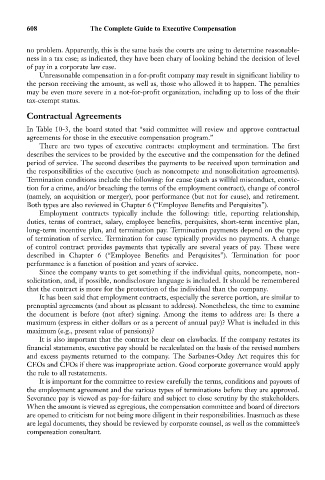Page 623 - Bruce Ellig - The Complete Guide to Executive Compensation (2007)
P. 623
608 The Complete Guide to Executive Compensation
no problem. Apparently, this is the same basis the courts are using to determine reasonable-
ness in a tax case; as indicated, they have been chary of looking behind the decision of level
of pay in a corporate law case.
Unreasonable compensation in a for-profit company may result in significant liability to
the person receiving the amount, as well as, those who allowed it to happen. The penalties
may be even more severe in a not-for-profit organization, including up to loss of the their
tax-exempt status.
Contractual Agreements
In Table 10-3, the board stated that “said committee will review and approve contractual
agreements for those in the executive compensation program.”
There are two types of executive contracts: employment and termination. The first
describes the services to be provided by the executive and the compensation for the defined
period of service. The second describes the payments to be received upon termination and
the responsibilities of the executive (such as noncompete and nonsolicitation agreements).
Termination conditions include the following: for cause (such as willful misconduct, convic-
tion for a crime, and/or breaching the terms of the employment contract), change of control
(namely, an acquisition or merger), poor performance (but not for cause), and retirement.
Both types are also reviewed in Chapter 6 (“Employee Benefits and Perquisites”).
Employment contracts typically include the following: title, reporting relationship,
duties, terms of contract, salary, employee benefits, perquisites, short-term incentive plan,
long-term incentive plan, and termination pay. Termination payments depend on the type
of termination of service. Termination for cause typically provides no payments. A change
of control contract provides payments that typically are several years of pay. These were
described in Chapter 6 (“Employee Benefits and Perquisites”). Termination for poor
performance is a function of position and years of service.
Since the company wants to get something if the individual quits, noncompete, non-
solicitation, and, if possible, nondisclosure language is included. It should be remembered
that the contract is more for the protection of the individual than the company.
It has been said that employment contracts, especially the severce portion, are similar to
prenuptial agreements (and about as pleasant to address). Nonetheless, the time to examine
the document is before (not after) signing. Among the items to address are: Is there a
maximum (express in either dollars or as a percent of annual pay)? What is included in this
maximum (e.g., present value of pensions)?
It is also important that the contract be clear on clawbacks. If the company restates its
financial statements, executive pay should be recalculated on the basis of the revised numbers
and excess payments returned to the company. The Sarbanes-Oxley Act requires this for
CEOs and CFOs if there was inappropriate action. Good corporate governance would apply
the rule to all restatements.
It is important for the committee to review carefully the terms, conditions and payouts of
the employment agreement and the various types of terminations before they are approved.
Severance pay is viewed as pay-for-failure and subject to close scrutiny by the stakeholders.
When the amount is viewed as egregious, the compensation committee and board of directors
are opened to criticism for not being more diligent in their responsibilities. Inasmuch as these
are legal documents, they should be reviewed by corporate counsel, as well as the committee’s
compensation consultant.

